bonsai
gardening
Orchids

Portulacaria afra bonsai
4 min read
Article written by Moshe Emergui
Want to purchase a Spekboom bonsai? Find out how.
Introduction
Portulacaria afra, is an evergreen succulent shrub or small tree originally from South Africa, where it reaches up to four meters in height. It is also known as the Elephant Bush, Jade Tree or Money Tree.
The stems are reddish-brown which contrast well against the green of the foliage. Leaves are small, luscious and vibrant green in colour. They are rounded in shape and form the dense appearance appreciated in more refined trees.
This succulent makes an excellent bonsai for beginner and professional alike due to its low maintenance requirements and hardiness, especially dry conditions.
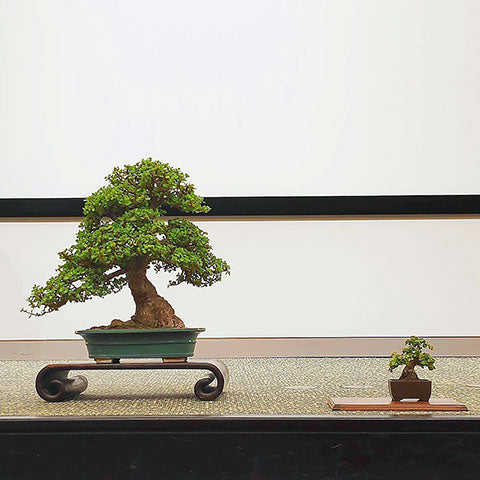
Image caption. A display by the author, including one of his Portulacaria afra.
Location
The ideal location for Portulacaria afra, regardless of size will be outdoors in full sun. However it can also be grown indoors near a well lit window. Trees will weaken in low light conditions making them susceptible to pests such as mealy bugs which suck the plentiful plant sap and secrete honeydew which in turn attracts ants and thus sooty mould.
Important to note is that the Portulacaria afra is sensitive to cold. In Israel it grows everywhere except the high mountains and the valleys where the temp drops below zero.
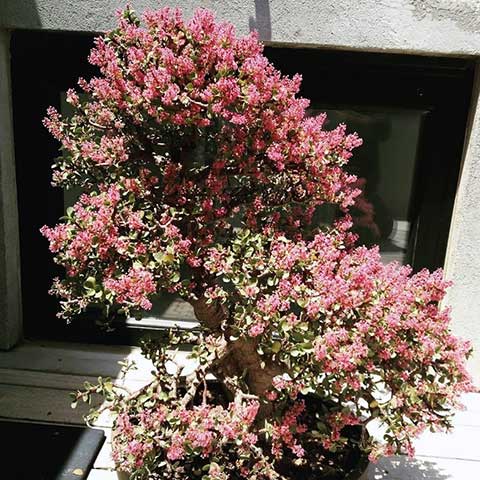
Image caption. Portulacaria in flower.
Watering
Portulacaria afra can hold large amounts of water in the trunk and leaves. In summer, during the growing season, water well but allow the plant to dry completely between irrigation. During winter, watering is reduced to as little as once every three weeks, and that only if it hasn't rained.
Training
Pruning
Portulacaria afra leaves are arranged in opposites, which alternate or rotate on branches. Cutting at pair of leaves will usually produce two branches at the base of the leaves. This pruning method is an effective way of achieving the desired shape with dense foliage pads in a relatively short period of time, should all the conditions be favourable.
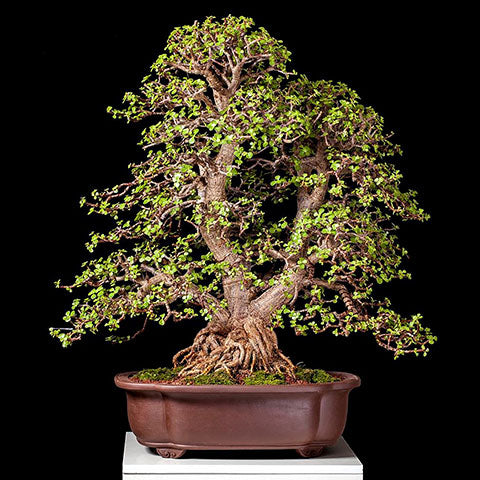
Image caption. A beautiful example of a Portulacaria afra partially defoliated and lightly wired. From the author's collection.
Wiring
Training with aluminium wire is possible though caution is needed when bending young branches as they snap easily.
Defoliation of a different kind
Succulent by nature, these plants hold large amounts of water in their trunk, branches and leaves. Long, immature branches tend to droop down due to their own weight. If this is not desired one of the most effective techniques to counteract this is partial defoliation, and in particular removing the top leaves.
Repotting
Actually repotting these trees is only necessary when the roots have completely filled the entire pot. The reason you would repot is to supply your tree with "fresh" soil which permits oxygen and water to flow freely, encouraging a more compact root system. When to repot requires some scrutiny as you do not wish to needlessly stop growth, neither do you wish to break a pot trying to get a thoroughly pot bound tree out of the container. As a general rule, most trees require repotting every two to three years. However since different trees grow at different rates, this schedule will not always be accurate.
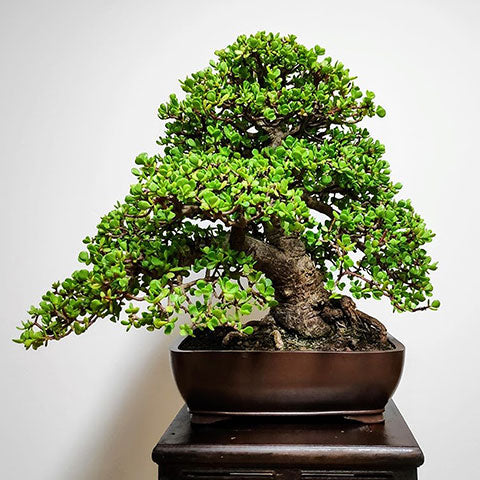
Image caption. Another of the author's trees
The best time for repotting Portulacaria afra is in the summer when the temperature rises and is consistently above 25 ° C. A well-draining soil mixture is best, such as 1 part Akadama mixed with 3 parts Pumice. In Israel we often use graded and rinsed lava stone, usually 2-4mm or 4-8mm in size, depending on the size of the tree, mixed with 20% peat moss.
Allow the soil to dry out somewhat before attempting repotting. The tree, along with all its soil, should then be removed from the pot. The outer and bottom most third of the tree's root mass should be removed. This is done by raking the soil away, then pruning back the roots. In most cases, it is not good to prune back more than one third of the tree's root mass. A thin layer of coarse particles is placed at the bottom of the pot. New soil should be carefully worked in around and under the root mass in such a manner as to avoid leaving any air pockets.
After repotting, you should initially water thoroughly. Moss or other ground covers can be used to cover the surface of the pot. Shelter the tree in a shaded warm area and water only sparingly until new growth establishes itself.
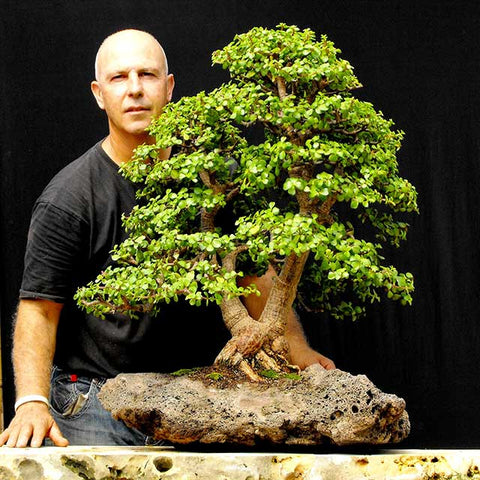
Image caption. The author, Moshe Emergui with one of his Portulacaria afra.
Moshe Emergui is a passionate bonsai artist and international demonstrator who loves to share his expertise and passion with enthusiasts around the world. Moshe has his own studio in Israel; Bonsai Art, shop and visitors center where the public can view his work. You can contact him via email (thebonsaiart@gmail.com) or visit his Facebook page.
Sign up for my newsletter now and don't miss another blog post.
1 Response
Leave a comment
Comments will be approved before showing up.
Recent Articles
-
Enthusiasts Top Wiring Tips
July 17, 2023
-
Top fertilizing tips
March 28, 2023
-
Top watering tips
February 13, 2023
-
Creating Japanese Maple forests
October 24, 2022
-
How to dig bonsai material
August 15, 2022
-
How I style bonsai and you can too
April 30, 2022
-
Swamp Cypress Bonsai Styling
July 03, 2021
-
How to hide large scars quickly
June 14, 2021
-
14 Tips for Field Growing Bonsai
May 31, 2021
-
Aquaria: An Introduction
January 06, 2021

Join now! Get R100
Expert Tips & Be the First to Know
Join our community, receive our best content, including seasonal tips, be the first to know of back in stock and new product launches.






Anamika
July 17, 2023
Thanks for amazing article its provides a good starting point for understanding the basics of caring for a Portulacaria afra bonsai.